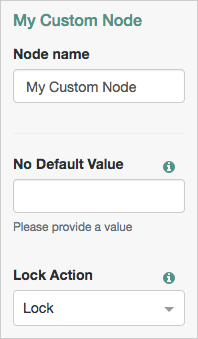Config interface
The Config interface defines the configuration data for a node.
A node can’t have state, but it can have configuration data. Configuration is per node.
Different nodes of the same type in the same tree have their own configuration.
You don’t need to write a class that implements the interface you define. AM automatically creates this as required.
Define node properties
Configure the node properties using methods. To provide a default value to the tree administrator, mark the method as default and define both a method and a value.
To omit a default value, define the method’s signature but not the implementation.
For example:
public interface Config {
//This will have no default value for the UI
@Attribute(order = 10)
String noDefaultAttribute();
//This will default to the value LOCK.
@Attribute(order = 20)
default LockStatus lockAction() {
return LockStatus.LOCK;
}
}For this Config example, a custom enum named LockStatus is returned.
The defined properties appear as configurable options in the tree designer view when adding a node of the relevant type. The options display to the user automatically.
Attribute names are used when localizing the node’s text. Learn more in Internationalize nodes.

You can find more information in the Config annotation type in the AM Public API Javadoc.
Attribute annotation
The Attribute annotation is required.
It defines the properties that appear as configurable options when you add or update a node.
Consider the following when using the Attribute annotation:
-
You must specify an integer value for
orderto determine the position of the attribute in the UI. -
Only use compatible Java types as attributes.
Compatible Java types
Java type Additional information java.lang.Stringjava.lang.Integerjava.lang.Longjava.lang.Booleanjava.lang.EnumUse any enum type.
org.forgerock.json.JsonValuejava.util.Localejava.net.URLchar[](char array)Use for passwords, but consider using
org.forgerock.secrets.Purposeinstead.java.util.Listjava.util.Setjava.util.MapUse with the following elements:
-
Boolean
-
Duration
-
Integer
-
Locale
-
Long
-
String
-
URL
-
JsonValue
-
char[]
Keys must be strings for
java.util.Map.java.util.OptionalUse with any of these compatible Java types.
org.forgerock.secrets.PurposeUse for secret values such as passwords.
You must annotate this type with
@SecretPurposeto define the secret label. -
-
Include
requiredValue = trueif the attribute is a required value.Any attributes that aren’t required should be an Optional attribute unless they’re already part of a collection through
List,Map, orSet.Attributes aren’t required by default when either
requiredValueis omitted or set tofalse. -
Specify one or more
validatorsif you need to validate the attribute values provided.Create any validator classes that you require by implementing the ServiceAttributeValidator interface.
Example
The following example creates a validator called
GreaterThanZeroValidator:public class GreaterThanZeroValidator implements ServiceAttributeValidator { @Override public boolean validate(Set<String> values) { boolean isValid = true; for (String value : values) { if (Integer.parseInt(value) <= 0) { isValid = false; break; } } return isValid; } }
For example:
public interface Config {
@Attribute(order = 1)
String domain(); 1
@Attribute(order = 2, validators = {GreaterThanZeroValidator.class}) 2
int exampleNumber();
@Attribute(order = 3, requiredValue = true)
boolean isVerificationRequired(); 3
@Attribute(order = 4)
@TextArea 4
String textBox();
@Attribute(order = 5)
@Password 5
char[] clientSecret();
@Attribute(order = 6)
default YourCustomEnum action() {
return YourCustomEnum.LockScreen; 6
@Attribute(order = 7, requiredValue = true, resourceName = "secretLabelIdentifier")
@SecretPurpose("am.authentication.nodes.customauth.%s.secret")
Purpose<GenericSecret> secretValuePurpose(); 7
};
}1 The domain attribute defines a String-type node property for display in the UI.
Access the attribute in the process method by using a reference to the config interface.
For example, config.domain().
2 Specify one or more validator classes as the validators parameter.
3 The boolean attribute is defined as a required value.
4 Use the TextArea annotation to indicate a String-type node property that needs a larger text input than a single line.
5 Use the Password annotation to mask the input characters and encrypt the value of the attribute.
6 A custom enum attribute. This provides type safety and negates the misuse of Strings as generic type-unsafe value holders. The UI will correctly handle the enum and only let the tree administrator choose from the defined enum values.
Learn more in the Attribute annotation type in the AM Public API Javadoc.
7 An identifier used to create a secret label for the node that maps to a secret in a secret store.
The default custom authentication node secret label is am.authentication.nodes.customauth.%s.secret
where %s is the value of the identifier. The identifier can only contain alphanumeric characters a-z, A-Z, 0-9,
and periods (.). It can’t start or end with a period.
|
To retrieve the secret using the identifier from your custom node, use the Secrets class, for example: Learn more in:
|